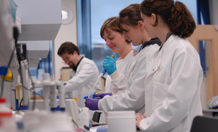-
- Information for new students
- About us
- News
- College news
- News archive
- Events
- Prospective undergraduates
- Prospective postgraduates
- Employability
- Research
- Staff profiles
- Arab and Islamic Studies
- Education
- Law
- Politics
- Sociology, Philosophy and Anthropology
- Exeter Q-Step Centre
- Outreach
- Alumni
- Contact us
- Health and Safety
- Current students
- Staff intranet

Trips to laboratories or special practical lessons do not help increase participation in STEM subjects, research shows.
No evidence that enrichment activities encourage pupils to study STEM A-levels, research finds
There is no evidence to suggest enrichment activities run to interest pupils in science, technology, engineering and maths results in significantly higher numbers of teenagers studying these subjects at A-level.
Research shows there is nothing to show offering trips to laboratories or special practical lessons alone helps increase participation in science, technology or mathematics qualifications after 16.
A new study shows that, despite these activities being embraced by individual schools and the Government and being enjoyable and providing opportunities, they have not had a direct impact on the numbers choosing to study AS or A-levels in these subjects.
The enrichment activities, which also include the work of STEM centres, support by higher education institutions and visits to schools by inspirational role models, are run to tackle a skills shortage in the UK and to improve understanding and enjoyment of these subjects.
Dr Pallavi Amitava Banerjee, from the Graduate School of Education at the University of Exeter, tracked the educational progress of children in Key Stage 3, when they were aged 11 or 12, in 2007 until they reached the end of Key Stage 5, when they were 18, using information from the official National Pupil Database. She was able to single out pupils who had participated in STEM enrichment activities thanks to data given to her by activity providers, and then see the A-level subjects they ended up choosing. Dr Banerjee did not find a clear link between subject choice and STEM A-level participation.
Dr Banerjee examined data from around 600,000 teenagers for the study – all those in Year 7 in 2007 in English state secondary schools. She was able to divide them into five groups:
- those who had taken part in STEM enrichment activities from the age of 11 to 16;
- those who had only taken part when aged 11 to 14;
- those who had only taken part from 14 to 16;
- those who took part irregularly;
- and those for which this information was not known.
Dr Banerjee was then able to track if these students had taken STEM subjects when aged 16 to 18 by looking at the National Pupil Database.
A total of 8.7 per cent of all those who had taken part in STEM activities during school went on to take biology A-level, 7.5 per cent for chemistry, 5 per cent for physics and 12 per cent for maths. The number of students who went on to study STEM A-levels having not taken part in STEM enrichment activities were very similar – 7.3 per cent for biology, 6.1 per cent for chemistry, 4.3 per cent for physics and 10 per cent for mathematics.
Students who only took part in STEM enrichment activities during only Key Stage 4, when aged 14 to 16, had the lowest STEM participation rates. Those who participated in interventions only during KS3, but never in KS4, were found to be slightly more likely to opt to take STEM subjects.
Students who qualified for free school meals, irrespective of their participation in STEM activities were the least likely to keep studying STEM subjects.
Dr Banerjee said: “While these enrichment and engagement activities may have been enjoyable and memorable for children, there is no evidence they encouraged them to keep on studying STEM subjects. There is also no evidence that these activities increased the numbers of children from poorer homes or from ethnic minority backgrounds studying technology, engineering, science or maths.
“Of course there are many factors which can affect the decisions young people make about the subjects they choose to continue studying at age 16, but it is hard to say STEM enrichment activities have a direct impact. They are one aspect which can help.
“It is essential for policymakers to consider whether, if these schemes are not working, perhaps the money could be spent elsewhere. Given the range of schemes being run it is also crucial to understand if any work better than others. Knowing the answer to this could help ensure money is spent on only the highest quality activities.
“It would also be useful to measure or investigate the other benefits – apart from continuation to AS and A-level study – of the STEM enrichment activities.”
‘Is informal education the answer to increasing and widening participation in STEM education?’ is published in the journal Review of Education.
Date: 9 May 2017
